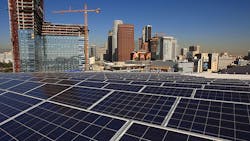Solar Power Buyers Loved 2018, But Panel Makers Loathed It
by Christopher Martin and Brian Eckhouse
Solar-panel makers had an awful 2018, but their customers really enjoyed it.
Module manufacturers lost about 40% of their market value this year, even as the number of installations hit another record. The problem? Most makers are having to sell solar modules for below cost to compete with Chinese supplies. That's helped buyers of solar power, which in some cases is now cheaper than fossil fuel-powered energy.
After a cataclysmic 2018 -- which began with Trump tariffs on imported equipment and got worse when China abruptly ended subsidies for solar installations -- solar companies are facing 2019 with continuing cost constraints but the promise of increasing demand.
"It's a tale of two cities," said Jeff Tannenbaum, the chairman of hedge fund Fir Tree, which sold solar developer sPower last year. "Manufacturers are not making as much for the panels, but everyone wants the solar farms. What you're seeing is an industry that's begun to mature."
The share losses this year were led by China's Yingli Green Energy Holding Co., and Germany's SolarWorld AG, with each down more than 80%.
"China slammed the brakes on the industry, and we immediately reduced our forecast for the year," Jenny Chase, lead solar analyst at Bloomberg NEF. Her team initially forecast China, the world's biggest market and supplier, would install a record 60 gigawatts this year, but that dropped to about 35 gigawatts in June. Recent brighter signs mean the figure is expected to end the year at about 43 gigawatts, or even slightly more.
"The latest news out of China is more positive, but the details aren't clear yet," she said.
From the wreckage, signs of turnaround are starting to emerge. After the most-leveraged suppliers went bankrupt or delisted, there were fewer options for investors sifting for bargains. A recovery in some stocks recently may be a sign of that, Jeffrey Osborne, an analyst at Cowen & Co., said by phone.
Global installations are on track to continue climbing for years as the same price reductions that are killing off manufacturers open significant new markets. A group of countries that aren't included in the major 52 markets that BNEF closely follows this year will install more solar than the U.S. for the first time. That group was on pace to add 10,350 megawatts, up from 877 megawatts in 2017.
Part of the reason for the boom: Solar is now often the cheapest new source of electricity, especially for resource-poor regions and islands that rely on imported diesel or coal.
"Cheaper modules hurts manufacturers, but they can help the industry," said Yuri Horwitz, chief executive officer of clean-energy developer Sol Systems.
Price declines will continue to pressure panel manufacturers, but at a much slower rate. BNEF forecasts just a 13% decline in 2019, when prior slumps often exceeded 30%. That's going to provide some breathing room for producers as they step up efforts to cut costs.
While manufacturers' stocks may not be in favor today, the demand for solar farms that use their modules has never been hotter. And there's mounting investor confidence in U.S. residential installers like Sunrun Inc., which more than doubled this year, and Vivint Solar Inc., which gained about 9%.
California could be ground zero for the industry's potential. Most new homes will be required to feature solar panels starting in 2020, local agencies are seeking additional near-term clean power and the state is mandating that all electricity be emissions-free by 2045. Other areas could follow suit, with signs Nevada could soon boost its renewables use.
Meanwhile, Xcel Energy Inc. -- which serves 3.6 million customers from Michigan to New Mexico -- earlier this month became the first major U.S. utility owner to pledge to fully phase out carbon-dioxide emissions. At the same time, auctions for solar energy around the world are driving down costs and making panels a commodity.
"I think we're near the bottom," Cowen's Osborne said. "There's still a sour taste for some investors, but the shock from the Chinese government and tariffs have largely been absorbed."
About the Author
Bloomberg
Licensed content from Bloomberg, copyright 2016.
